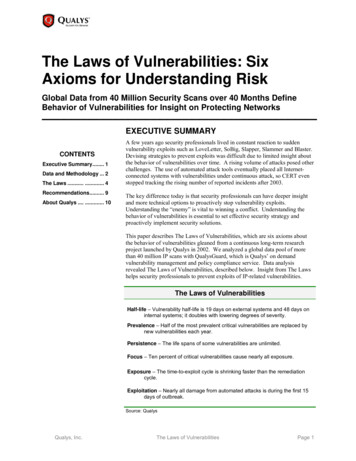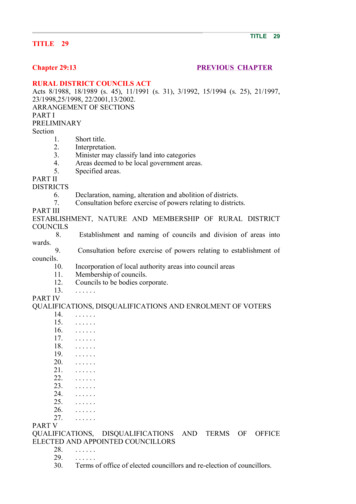
Transcription
The Laws of Vulnerabilities: SixAxioms for Understanding RiskGlobal Data from 40 Million Security Scans over 40 Months DefineBehavior of Vulnerabilities for Insight on Protecting Networks EXECUTIVE SUMMARYCONTENTSExecutive Summary. 1Data and Methodology . 2The Laws . . 4Recommendations. 9About Qualys . . 10A few years ago security professionals lived in constant reaction to suddenvulnerability exploits such as LoveLetter, SoBig, Slapper, Slammer and Blaster.Devising strategies to prevent exploits was difficult due to limited insight aboutthe behavior of vulnerabilities over time. A rising volume of attacks posed otherchallenges. The use of automated attack tools eventually placed all Internetconnected systems with vulnerabilities under continuous attack, so CERT evenstopped tracking the rising number of reported incidents after 2003.The key difference today is that security professionals can have deeper insightand more technical options to proactively stop vulnerability exploits.Understanding the “enemy” is vital to winning a conflict. Understanding thebehavior of vulnerabilities is essential to set effective security strategy andproactively implement security solutions.This paper describes The Laws of Vulnerabilities, which are six axioms aboutthe behavior of vulnerabilities gleaned from a continuous long-term researchproject launched by Qualys in 2002. We analyzed a global data pool of morethan 40 million IP scans with QualysGuard, which is Qualys’ on demandvulnerability management and policy compliance service. Data analysisrevealed The Laws of Vulnerabilities, described below. Insight from The Lawshelps security professionals to prevent exploits of IP-related vulnerabilities.The Laws of VulnerabilitiesHalf-life – Vulnerability half-life is 19 days on external systems and 48 days oninternal systems; it doubles with lowering degrees of severity.Prevalence – Half of the most prevalent critical vulnerabilities are replaced bynew vulnerabilities each year.Persistence – The life spans of some vulnerabilities are unlimited.Focus – Ten percent of critical vulnerabilities cause nearly all exposure.Exposure – The time-to-exploit cycle is shrinking faster than the remediationcycle.Exploitation – Nearly all damage from automated attacks is during the first 15days of outbreak.Source: QualysQualys, Inc.The Laws of VulnerabilitiesPage 1
DATA AND METHODOLOGYThe goal of Qualys’ research was to understand how critical vulnerabilitiesbehave over time in the real world.Data was automatically and anonymously drawn from the largest collection ofvulnerabilities in the world – the Qualys KnowledgeBase for QualysGuard. TheKnowledgeBase contains signatures and identification statistics for more than4,800 network vulnerabilities of varying severity within these categories:Vulnerability Categories in Qualys KnowledgeBase40,691,913Total IP scans45,378,619Total criticalvulnerabilitiesidentified1,595Unique criticalvulnerabilitiesidentifiedQualys, Inc.Back Doors and Trojan HorsesAppliancesBrute Force AttacksInformation / Directory ServicesCGISMB / Netbios WindowsDatabasesFile SharingDNS and BindSMTP and MaileCommerce ApplicationsApplicationsFile Transfer ProtocolSNMPFirewallsTCP/IPGeneral Remote ServicesWeb ServersHardware and NetworkX-WindowsData for this analysis was derived from 40,631,913 IP scans with QualysGuardconducted globally during the period of 8 September 2002 and 31 January 2006.About 70 percent of the data was from global enterprise scans and 30 percentfrom random trials of QualysGuard. All scan data was anonymously gatheredwithout correlation to any specific user or system.There were 45,378,619 critical vulnerabilities identified by these scans. Acritical vulnerability provides an attacker with the ability to gain full control ofthe system, and/or leakage of highly sensitive information. For example, criticalvulnerabilities may enable full read and/or write access to files, remoteexecution of commands, and the presence of backdoors. QualysGuard assignsvulnerabilities like these a rating of Level 4 or 5 – the most severe threats tonetwork security. Vulnerabilities can stem from bad code, a variety of malware,or from errors in system or network configuration.The scans identified 1,595 unique critical vulnerabilities out of 1,972 in theKnowledgeBase. This means 80 percent of known critical vulnerabilitiesshowed up in real world scans.Data during the last year and a half of the testing period was enhanced by risingscan statistics for devices with internal-facing IPs. Initial scans withQualysGuard were restricted to devices with external-facing IPs. Qualys lateradded capability to scan IPs on the intranet using a distributed scannerappliance. Currently, one-third of the devices scanned by QualysGuardcustomers are inside the network perimeter on an intranet.The Laws of VulnerabilitiesPage 2
The figure below shows the study’s quarter-by-quarter volume of IP scans withQualysGuard segmented by external and internal targets.Total IP Scans for “Laws” Data PoolNew Trend60% of newcriticalvulnerabilities arein clientapplications.Almost none are ina wireless device.Qualys, Inc.Qualys analyzed the vulnerability data with standard statistical techniques toidentify: Window of exposure Lifespan of critical vulnerabilities Resolution response Trends over time Vulnerability prevalenceA major new trend is the shift in critical vulnerabilities from server to clientapplications. Earlier data in this analysis showed most vulnerabilities were inserver applications such as web server, mail server, and operating systemservices. Data now show more than 60 percent of new critical vulnerabilities arein client applications such as web browser, backup software, media players,antivirus, Flash and in other tools. Vulnerabilities for client applications aresubject to the same Laws of Vulnerabilities as those for server applications.The data analysis also debunked a popular myth that wireless networks are asignificant security vulnerability for enterprise networks. According to the datain this study, just one in nearly 20,000 critical vulnerabilities is caused by awireless device. Future analysis will monitor this issue, especially as wirelessbecomes more widely adopted by enterprises throughout the world.The Laws of VulnerabilitiesPage 3
THE LAWS OF VULNERABILITIES1Half patchedHalf of IPs with acritical vulnerabilityare still exposedafter the respective19 or 48 day halflife.Half-LifeVulnerability half-life is 19 Days on external systems and 48days on internal systems; it doubles with lowering degrees ofseverity.Half-life is the duration of half a process. The term often connotes danger.Half-life plays a critical role in protecting people, such as with radioactivity, orcalculating the impact of improperly using an old drug. Half-life is equallyimportant in understanding and preparing network defenses for malware andother vulnerabilities.The data show that the half-life of critical vulnerabilities is shrinking. Ouranalysis for The Laws in 2003 found that half-life was 30 days, applicablemostly to external systems. Now the half-life for external systems has shrunk to19 days. Half-life for internal systems is 48 days.The meaning of these statistics is that for even the most dangerousvulnerabilities, it still takes organizations 19 days to patch half of vulnerableexternal systems. Patching half of internal systems takes 48 days – more than150 percent longer than for patching external IPs! Exposure of unpatchedsystems continues during the significantly long period of half-life dissipation.As an example of the Law of Half-Life, the illustration below shows a half-lifetime plot curve for the Microsoft Windows Color Management Module RemoteCode Execution vulnerability following its appearance in July 2005. Scan datashow incidents falling about every two weeks. Continued existence of theunpatched vulnerability triggered short bursts of new incident activity as thehalf-life curve fell over time.Half Life of Microsoft Windows Color Management ModuleRemote Code Execution VulnerabilityCVE-2005-1219 – Released July 2005Qualys, Inc.The Laws of VulnerabilitiesPage 4
2PrevalenceHalf of the most prevalent critical vulnerabilities are replacedby new vulnerabilities each year.Prevalence is the degree to which the vulnerability poses a significant threat.The ongoing global threats to people by dangerous viruses such as SARS orAvian Flu have significant prevalence until implementation of precautionsreduces threats to a negligible level. With digital viruses and worms, wediscovered similar trends.Look OutHalf of criticalvulnerabilitieschange every year.We measured the prevalence of the most critical digital vulnerabilities for an 18month period and learned that half are replaced by new vulnerabilities each year.This means there is ongoing change to the most important threats to ournetworks and systems.The table below presents data to illustrate the Law of Prevalence. The mostcritical vulnerabilities found in customer security scans are listed by CVEnumber and ranked at three points in time: January 2005, June 2005 and January2006. The gray highlight bars show a consistent shift in prevalence. After oneyear, eight of the top 13 vulnerabilities are still on that list. Five were replacedby new vulnerabilities.Prevalence Table of the Most Critical 006Microsoft Office XP Vulnerability Could Allow Remote CodeExecution (MS05-005)Windows Media Player and Windows Messenger Remote CodeExecution (MS05-009)CVE-2004-0848XCVE-2004-1244XMicrosoft Server Message Block Remote Code Execution (MS05011)CVE-2005-0045XXMicrosoft Windows OLE and COM Remote Code ExecutionVulnerabilities (MS05-012)DHTML Editing Component ActiveX Control Remote Code Execution(MS05-013)Microsoft Hyperlink Object Library Buffer Overflow (MS05-015)Microsoft Message Queuing Buffer Overflow (MS05-017)Windows Multiple Denial of Service and Privilege ElevationVulnerabilities (MS05-018)Microsoft Exchange Server Remote Code Execution (MS05-021)Microsoft SMB Remote Code Execution Vulnerability (MS05-027)Microsoft Windows Web Client Service Remote Code ExecutionVulnerability (MS05-028)Windows Color Management Module Remote Code Execution(MS05-036)Windows Plug and Play Remote Code Execution (MS05-039)Windows Print Spooler Service Remote Code Execution (MS05-043)Microsoft Windows Client Service For Netware Buffer OverflowVulnerability (MS05-046)Microsoft Plug and Play Remote Code Execution and Local PrivilegeElevation Vulnerability (MS05-047)Microsoft DirectShow Remote Code Execution Vulnerability (MS05050)Microsoft MSDTC and COM Remote Code Execution Vulnerability(MS05-051)Microsoft Windows Graphics Rendering Engine WMF Format CodeExecution alys, Inc.The Laws of 5-1980XCVE-2005-4560XPage 5
3PersistenceThe life spans of some vulnerabilities are unlimited.Many have experienced the frustration of having just patched a criticalvulnerability, only to find that a variant exploit appears – and forces animmediate restarting of the patching process. The risk of re-infection also canhappen when we deploy new PCs and servers with images of faulty unpatchedoperating system and/or application software.Analysis of the data reveals that the life spans of some vulnerabilities areunlimited. One example is the SQL Slammer vulnerability, which demonstrateda nasty and persistent recurrence. Exploitation enabled a denial of serviceattack. Microsoft announced the existence of this vulnerability in July 2002 andpublished a patch at the same time. The chart below shows the first and biggestattack by a worm exploiting this vulnerability was in February 2003. Thenumber of vulnerable systems dropped through March, then suddenly jumped totwo-thirds of the original attack level and remained there for a few more months.Unpatched systems are still vulnerable to this threat today.Persistence of MS-SQL 8.0 UDP Slammer WormBuffer Overflow VulnerabilityCAN-2002-0649 – Released July 2002Qualys, Inc.The Laws of VulnerabilitiesPage 6
A dramatic demonstration of The Law of Persistence was the SNMP Writablevulnerability. Exploits of this vulnerability appeared in late 2002 and recurredwith aggressive regularity for two years before subsiding in summer 2005.Persistence of SNMP Writable Vulnerability1Multiple CVEs – Released Feb. 20004Work SmartPatching the mostcriticalvulnerabilities firsteliminates mostexposure.FocusTen percent of critical vulnerabilities cause nearly allexposure.The old 90 / 10 rule also applies to occurrence of critical vulnerabilities. Thedata in this study revealed that 90 percent of vulnerability exposure is caused by10 percent of critical vulnerabilities. The figure below graphically depicts theexposure caused by 500 of the most critical vulnerabilities discovered duringthis study. The few distinct or small clusters of spikes correspond to specificvulnerabilities. Two had significant spikes of exposure: the Windows NullSession vulnerability and the NETBIOS / SMB Share Password vulnerability.Overall, only 10 percent caused significant exposure.Security professionals can leverage the Law of Focus by targeting initialremediation efforts on critical vulnerabilities with the highest degree ofexposure. Simply eliminating those vulnerabilities first will reduce 90 percentof the sources of risk.1The SNMP Writable vulnerability had multiple CVE numbers, including CVE1999-0792, CVE-2000-0147, CV-2000-0515, CVE-2001-0380, CVE-20011210, and CVE-2002-0478.Qualys, Inc.The Laws of VulnerabilitiesPage 7
5Patch FasterAccelerated exploitsmust be patchedfaster to eliminatesystem exposure.ExposureThe time-to-exploit cycle is shrinking faster than theremediation cycle.Early data in this research project noted that that 80% of critical vulnerabilityexploits were available within 60 days of their public announcements. Theupdated Law of Half-Life shows this period is shrinking. Half-life is now 19days for external systems and 48 days for internal systems. Since the durationof vulnerability announcement-to-exploit-availability is dramatically shrinking,organizations must eliminate vulnerabilities faster. The updated axiom restatesthe idea behind the Law of Exposure as 80 percent of critical vulnerabilityexploits are available within the first half-life after their appearance.Exposure Curve of Critical VulnerabilitiesSome exploits are achieving the status of “zero-day” or “near zero day,”meaning that the exploit is available on the same day of the vulnerabilityannouncement. A recent example was the WMF vulnerability, also known asMicrosoft Windows Graphics Rendering Engine WMF Format Code Execution(CVE-2005-4560). Exploitation of this vulnerability enabled execution ofremote code and user account access. Exploitation was first observed in thewild on 26 Dec. 2005. Global scan data showed more than 50 websites wereQualys, Inc.The Laws of VulnerabilitiesPage 8
infected two days later as exploitation took hold and then quickly expanded.Microsoft did not release a patch until 5 Jan. 2006.The Zotob worm (CVE-2005-1983) is another recent example of quickexploitation. The worm is enabled by a stack-based buffer overflow in the Plugand Play (PnP) service for Microsoft Windows 2000 and Windows XP ServicePack 1. It allows remote attackers to execute arbitrary code and local users togain unauthorized administrator privileges. Microsoft announced thevulnerability on August 11, 2005. Microsoft said exploit code became availablethe next day.The rapid availability of exploits like these creates significant exposure fororganizations until they patch all their vulnerable systems.6ExploitationNearly all damage from automated attacks is during the first15 days of outbreak.Automated attacks pose a special hazard to network security because they inflictdamage swiftly with little time for reaction. The Law of Exploitation shows thatsevere damage from a vulnerability exploit is most likely to happen right after itappears. The most recent data show that initial period of severe damage isduring the first 15 days of outbreak.The graph below superimposes available outbreak data for six majorvulnerabilities: Blaster, Code Red, Nachi, Sasser, Slapper and Zobot. For eachcritical vulnerability, the peak number of incidents occurs early after itsrespective appearance and swiftly drops off.RECOMMENDATIONSThe Laws of Vulnerabilities demonstrate that known critical risks are far moreprevalent than anyone has imagined. Data for our study document the persistentability of attackers to gain full control of systems – including access to highlysensitive information such as financial data and intellectual property. The mosteffective thing organizations can do to mitigate fallout from vulnerabilities is toaccelerate efforts to identify and remediate critical weaknesses. Continue use ofQualys, Inc.The Laws of VulnerabilitiesPage 9
an automated vulnerability management system like QualysGuard will shortenhalf-lives of vulnerabilities and reduce risks for all organizations.Qualys recommends that organizations regularly scan networks and systems forcritical vulnerabilities and set a remediation goal of shortening the half-life by20 percent by the end of 2006. Accomplishment of this goal will reduce thecurrent half-life of external systems from 19 to 15 days, and of internal systemsfrom 48 to 38 days.ABOUT QUALYSWith more than 2,000 subscribers ranging from small businesses tomultinational corporations, Qualys, Inc. has become the leader in on demandvulnerability management and policy compliance. The company allows securitymanagers to strengthen the security of their networks effectively, conductautomated security audits and ensure compliance with internal policies andexternal regulations. Qualys' on demand technology offers customers significanteconomic advantages, requiring no capital outlay or infrastructure to deploy andmanage. Its distributed scanning capabilities and unprecedented scalabilitymake it ideal for large, distributed organizations. Hundreds of large companieshave deployed Qualys on a global scale, including AXA, DuPont, HersheyFoods, ICI Ltd, Novartis, Sodexho, Standard Chartered Bank and many others.Qualys is headquartered in Redwood Shores, California, with European officesin France, Germany and the U.K., and Asian representatives in Japan,Singapore, Australia, Korea and the Republic of China.Qualys, Inc.1600 Bridge ParkwayRedwood Shores, Calif.94065 ― USA800.745.4355www.qualys.com COPYRIGHT 2006 QUALYS, INC. ALLRIGHTS RESERVED.Qualys, the Qualys logo, andQualysGuard are trademarks of Qualys,Inc. All other company, brand andproduct names may be marks of theirrespective owners. 2: 02-13-2006Qualys, Inc.The Laws of VulnerabilitiesPage 10
19 or 48 day half-life. The data show that the half-life of critical vulnerabilities is shrinking. Our analysis for The Laws in 2003 found that half-life was 30 days, applicable mostly to external systems. Now the half-life for external systems has shrunk to 19 days. Half-life for internal systems is 48 days.










